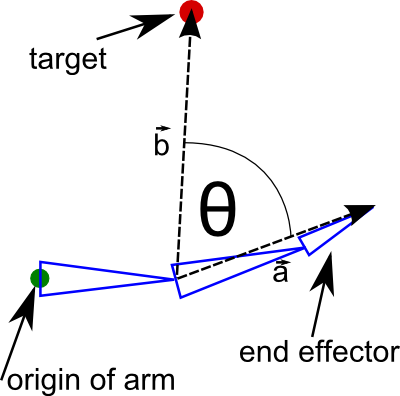Inverse Kinematics For Virtual Robot Arm
Inverse Kinematics (IK) is the method of automatically calculating the locations/angles of a mechanical system based upon a desired end location/state. For a robotic arm, it is common that the end point of the arm is set, as if to grab an object, and for the arm to be able to calculate each position. This page outlines some basic methods for IK, including Jacobian Transpose, Jacobian Psuedo-Inverse, and Cyclic Coordinate Descent. Also present is a 2D visualisation method using pygame.
Cyclic Coordinate Descent
Cyclic Coordinate Descent (CCD) is a simple algorithm that primarily seeks to minimise the distance, or error, between the location of the end effector and target location.
Starting at the outermost end link (the end effector itself), each link is rotated such that the error is minimised.
Crucially, it should be noted that for all subsequent links after the end effector, the error is minimised purely for moving the current link, while keeping any further link angles constant.
The angle is calculated using the dot product between the vector from the links origin to the end effector (pe-pc) and the vector from the links origin to the target (goal-pc).
The dot product can be seen in figure 1. The angle theta can be calculated.

Code Snippet
The CCD algorithm is implemented below. A full example is located further below.
References
- https://sites.google.com/site/auraliusproject/ccd-algorithm
- http://www.ryanjuckett.com/programming/cyclic-coordinate-descent-in-2d/
Jacobian Transpose
Included in same download file: not yet written up
Code Snippet
BLARGH
References
Jacobian Psuedo-Inverse
Included in same download file: not yet written up
Code Snippet
BLARGH LJ
References
Requirements
- Python 2.7x
- Pygame
- NumPy
Notes
- Each arm segment, in
self.sections, has location/angle relative to the previous arm section.self.sectionsGlobalPos()translates this to the global coordinates neccessary for the inverse kinematics and rendering. The major advantage of storing the information in this way is that it easily translates to a real world robot arm. - Theta is in radians.
- Position data is stored in a 3x1 numpy array.
- Very little work should be needed to convert to a true 3D IK system